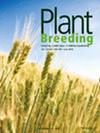温带和热带爆米花群体的特征及玉米蛋白和淀粉含量的GWAS
IF 1.8
4区 农林科学
Q2 AGRONOMY
引用次数: 0
摘要
由于测量膨胀体积(EV)简单且价格低廉,因此在选择玉米蛋白、淀粉、脂质和细胞壁成分的含量时,爆米花育种者开发了高质量的单杂交。然而,一些品质相关性状的量化方法可以应用于爆米花育种,提高品质选择效率。本研究的目的是评估玉米蛋白和淀粉的定量方法,用于玉米育种,确定玉米蛋白和淀粉含量的温带和热带群体,并确定这些品质相关性状的候选基因。我们对286株植物进行了基因分型和表型分型。对于总玉米蛋白和玉米蛋白亚基的定量,我们选择“芯片实验室”微流控电泳。对于淀粉和直链淀粉/支链淀粉的定量,我们选择Megazyme的直链淀粉/支链淀粉试剂盒测定。与热带种群相比,温带种群EV较高(36.0%),19 kDa玉米蛋白亚基含量较高(32.0%),21、22和27 kDa玉米蛋白亚基含量较低(分别为- 1543.0%、- 40.0%和- 47.0%),10 kDa玉米蛋白含量无统计学差异。尽管两种群在淀粉、直链淀粉和直链淀粉/支链淀粉比值方面存在统计学差异,但差异不显著(- 2.0% ~ 8.0%)。19和22 kDa玉米蛋白(2个直链淀粉蛋白和1个淀粉蛋白)有13个候选基因,重点是编码19和22 kDa α -玉米蛋白的基因,位于4号染色体上。所评价的定量方法可用于爆米花育种,但样本量有限,主要是成本问题。本文章由计算机程序翻译,如有差异,请以英文原文为准。
Characterization of temperate and tropical popcorn populations and GWAS for zeins and starch contents
Because measuring expansion volume (EV) is simple and inexpensive, popcorn breeders have developed high-quality single crosses ignoring the contents of zeins, starch, lipids, and cellular wall components in selection. However, some methods of quantification of these quality-related traits can be applied to popcorn breeding, increasing the selection efficacy for quality. The objectives of this study were to assess methods of zeins and starch quantification that can be used in popcorn breeding, characterize a temperate and a tropical populations for zeins and starch contents and identify candidate genes for these quality-related traits. We genotyped and phenotyped 286 plants. For quantification of total zeins and zein subunits we choose the ‘lab-on-a-chip’ microfluidic electrophoresis. For quantification of starch and amylose/amylopectin, we choose the Megazyme's Amylose/Amylopectin kit assay. The temperate population has superior EV (36.0%), a higher level of the 19 kDa zein subunit (32.0%), lower levels of the 21, 22 and 27 kDa subunits (−1543.0%, −40.0% and −47.0%, respectively) and no statistical difference for the 10 kDa zein content, relative to the tropical population. Although there are statistical differences between the two populations regarding starch, amylose, and amylose/amylopectin ratio, the differences are not significant (−2.0% to 8.0%). Thirteen candidate genes were identified for the 19 and 22 kDa zeins, two for amylose and one for starch, with emphasis on the genes coding for the 19 and 22 kDa alpha-zeins, located on chromosome 4. The evaluated quantification methods can be used in popcorn breeding but for a limited number of samples, mainly because costs.
求助全文
通过发布文献求助,成功后即可免费获取论文全文。
去求助
来源期刊

Plant Breeding
农林科学-农艺学
CiteScore
4.40
自引率
5.00%
发文量
74
审稿时长
3.0 months
期刊介绍:
PLANT BREEDING publishes full-length original manuscripts and review articles on all aspects of plant improvement, breeding methodologies, and genetics to include qualitative and quantitative inheritance and genomics of major crop species. PLANT BREEDING provides readers with cutting-edge information on use of molecular techniques and genomics as they relate to improving gain from selection. Since its subject matter embraces all aspects of crop improvement, its content is sought after by both industry and academia. Fields of interest: Genetics of cultivated plants as well as research in practical plant breeding.
 求助内容:
求助内容: 应助结果提醒方式:
应助结果提醒方式:


